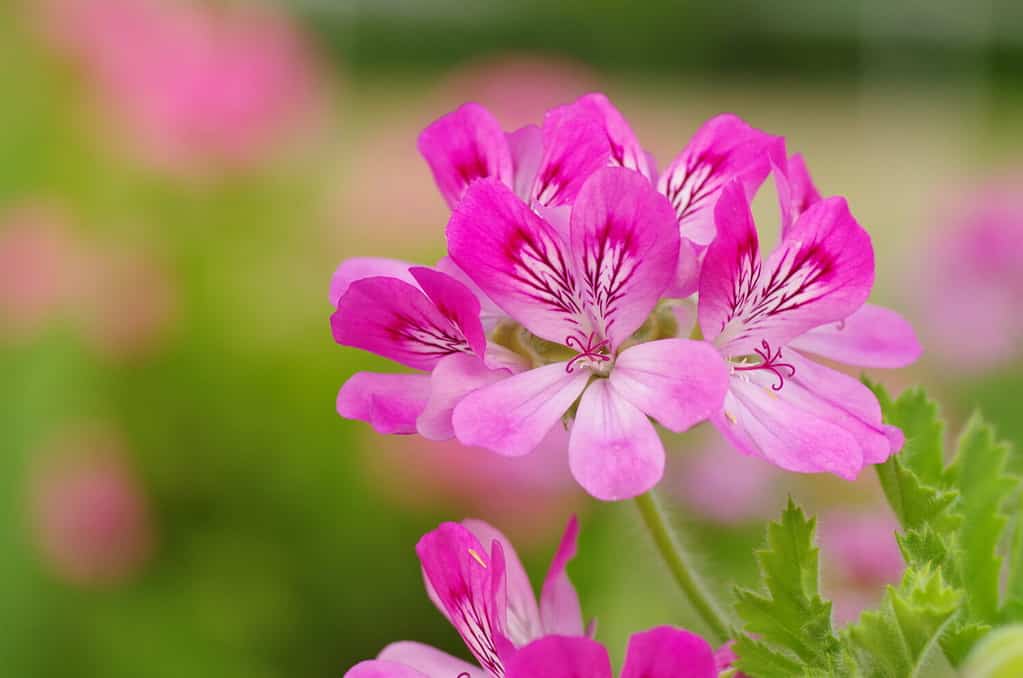Can geraniums survive outside in the winter? The answer is a murky depends. It depends on where you live mostly, although a variety of other factors come into play as well. Geraniums are tender perennials. Their ability to survive outdoor winter conditions depends on the specific species or cultivar, as well as the local climate. Geraniums are hardy in USDA zones 9-11, where winters are mild. In these zones, geraniums can often survive outdoors year-round. In colder climates, geraniums are treated as annuals or brought indoors for the winter. Continue reading to discover three tips for keeping your geraniums alive over winter.

Geranium’s ability to survive outdoor winters depends on the species or cultivar and the local climate.
©Studio Photo MH/Shutterstock.com
What is a Geranium?
Geraniums or cranesbill are a genus of flowering plants that belong to the family Geraniaceae. There are over 400 species of geraniums. They are herbaceous perennials, meaning they have soft, non-woody stems. Geranium leaves are lobed and various shapes and sizes. Geraniums produce five-petaled flowers that come in a variety of colors, including shades of pink, purple, blue, and white. After flowering, geraniums produce pods. They resemble a beak or a crane‘s bill, which is how they got the common name cranesbill.

Geraniums produce five-petaled flowers that come in a variety of colors, like pink, purple, blue, and white.
©mutsu7211/Shutterstock.com
1. Mulch!
If you wish to keep your geraniums in the ground over winter, add a layer of mulch around the base of the plants to insulate the roots and protect them from extreme cold. Before adding the mulch, you should cut your plant back to within an inch or 2 (2.5 – 5cm) of the ground. The best time to prune your geraniums is when the nighttime temperatures begin to dip into the mid-40s° F (7° C). Once accomplished, cover the plant and at least 3 inches (7.5 cm) beyond it, to ensure it stays warm. If you live in a region that experiences exceptionally harsh winters, placing a plastic bucket over your mulched plant will keep it warm on even the coldest days and nights.
2. Bring Them In
I know, it’s a hassle to drag pots and they take up space, but if you’re invested in keeping your plants alive throughout the winter, bringing them indoors isn’t a bad idea. This is especially true if you live in USDA Hardiness Zone 6 or lower. The lower the number of the hardiness zone, the colder the winter. So, while gardeners in zones 7 and 8 might have luck covering their plants, folks farther north will not experience the same level of success.
Leave Them in the Planter
If your plants are already in containers, simply prune them back to an inch or two (2.5-5 cm) above the soil. Place them in a basement or dark room and forget about them, mostly. Watering lightly monthly is suggested. Once the temperature starts to rise in the spring, slowly acclimate your plants to the light, by placing them in a room with indirect light for a few days to a week. Once the temperature remains in the mid 40s (7° C) at night, you can return your pots to the great outdoors.
Bare-Root Method
Another method involves removing the pruned plant from the container. Shake all of the soil from around the roots. This is called the bare-root method. Once the roots are free of soil, hang the plant upside down in a basement or other cool, dark place. When the temperature rises, simply re-pot the plant. Using the bare-root method, you can also place the geraniums in a paper bag for the winter. The closed bag should be kept in the dark and away from any heat. In the spring, simply remove the plant and re-pot. As above, be certain to slowly awaken your plants.

Another method involves removing the pruned geranium from its container.
©A-Z-Animals.com/Kathryn Koehler
3. Let Them Go
If you live in a region that has harsh winters, perhaps the best you can do for your geranium is wish it Vaya con Dios once the mercury dips below freezing. In most places in the U.S., excluding the deep south, Hawaii, and Puerto Rico, geraniums are sold as and treated like annuals. Chances are your geraniums will not survive, even if efforts are made. When you live in an area with cold winters, it will take a few weeks to a month to establish blooms after reacclimating the plants to the outdoors. Container and bedding plants purchased at the garden center will be weeks ahead, thus providing earlier blooms. So, while the idea of overwintering your geraniums may seem romantic, earth-friendly, or simply frugal, it’s not necessarily the most satisfying.
Regardless of how you choose to overwinter your geraniums, one thing is certain: these perennial favorites are always welcome!
The photo featured at the top of this post is © Jane Nadezhina/Shutterstock.com
Thank you for reading! Have some feedback for us? Contact the AZ Animals editorial team.







